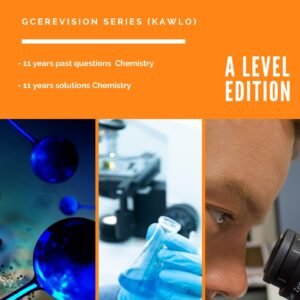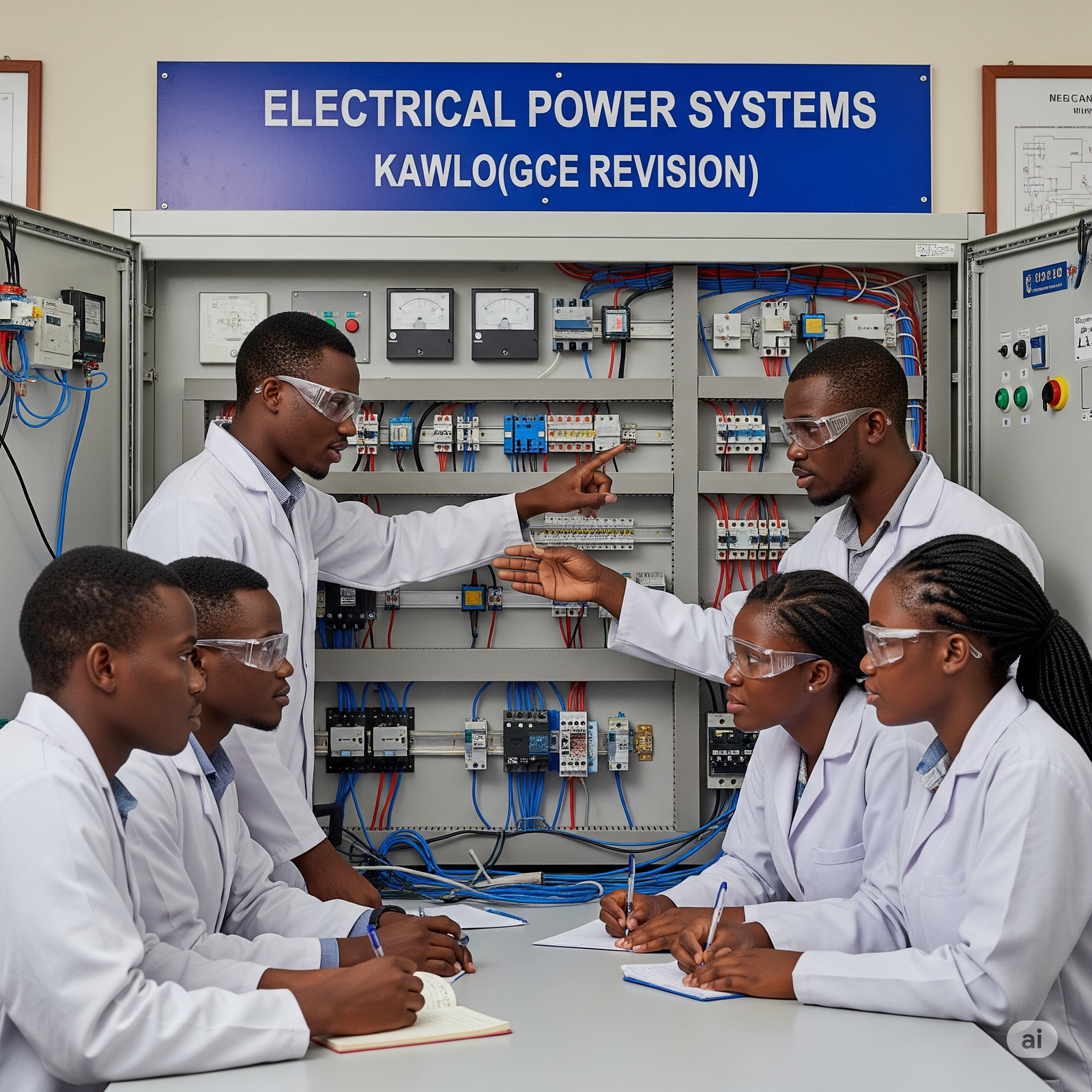cameroon gce june 2003 chemistry Paper 2
To DOWNLOAD CAMEROON GCE JUNE 2003 CHEMISTRY Paper 2 click on the link below

JUNE 2003
SECTION A
You are advised to attempt ALL questions in this section; the mark awarded will be the total for your best FIVE answers.
Write your answers in the spaces provided, Useful data will be found on the last page.
1, Rock salt is impure sodium chloride containing some insoluble earthly impurities. 1
(a) Briefly describe how you would proceed to obtain
A pure specimen of solid sodium chloride from rock salt (3marks)
b) Briefly describe how you would obtain a sample of dry chlorine from a sample of the sodium chloride*in the laboratory (4marks)
(c) How would you modify the set up and reagents in
(b) above to obtain a sample of dry hydrogen chloride?
(2marks)
(a) Give one domestic use of sodium chloride
(l mark)
2 Octadecanoic (Stearic) acid has the formula C17H35 COOH. It melts at and boils at 383°C. One mole of the acid is neutralized by one mole of potassium hydroxide to form one mole of potassium octadecanoate (stearate)
(a) What is the temperature range over which the add
is a liquid? ….( l mark)
(b) (i) Write an equation for the reaction between the
acid and potassium hydroxide
What common name could be given to potassium octadecanoate?
(ii) Name an industrial process in which the neutralization reaction sited above could be
encountered (3marks)
c) (i) State one natural source from which this acid could be obtained during the industrial process (ii) What class or type of compound is contained in this natural source from which the acid could be
Obtained? (2marks)
d) Potassium octadecanoate could react with water containing Ca2+ (aq) ions in solution to deposit a greyish white solid.
e)
(i) Write an equation for the reaction between
potassium octadecanoate and calcium hydrogen carbonate in the water
(ii) What change would take place in the water after
the reaction in d)(i) has taken place? (4marks)
3. Tellurium, Te has an atomic mass of 128 and an electronic configuration of 2,8,18,18,6
a. What is the atomic number of Tellurium? .(l mark)
b. Suggest the group and the period of the Periodic Table to which Tellurium could belong. (2marks)
c. Would Tellurium be a metal or a non-metal? Give a reason for your answer (2marks)
(d) 3.2g of tellurium reacts with oxygen of air when heated to give 600 cm3 of gaseous tellurium oxide at room temperature and atmospheric pressure. The formula of the tellurium oxide is TeO2
(i) Calculate the number of moles of tellurium used
(ii) Calculate the number of moles of tellurium oxide
Formed
(iii)Show how you would use the information worked out fco write a balanced equation for the reaction between tellurium and oxygen (5marks)
4. Study diagrams A and B below in which hydrogen chloride and chlorine gases are respectively parsed over heated iron filings in Silica tubes. The products formed by the reactions are deposited at the points shown on the diagrams.


(a)Write equations for the reactions taking place between iron and:
(ii)hydrogen chloride
(i) chlorine (2marks)
(a) Explain why the products formed in A and B are
deposited at different points in the tubes as shown below ….(2marks)
(b) (i) Name the substance that is burning at the mouth of the tube in A and the product formed by the burning
(c)
(ii) What substance may be directed to a fume cupboard in B and why is it so directed? … (4marks)
(d) Write an equation to show how you would convert
a solution of the product formed in A (2marks)
5. An element with symbol X, (X is not usual symbol of the element) is just below potassium on the Periodic Table and above it on the electrochemical (activity)series.
(a) Write the formula of a compound of X in which X could be found naturally and suggest a possible environment where this compound would be found
(2marks)
(b) (i) How would x be extracted from its compound
in which it occurs?
(ii) How would x be stored? (2marks)
(c) Describe what you would expect to see when a
piece of x is putin water (1 mark)
(a) Write an equation for the reaction of x with water
…. (1 mark)
(e) Give the formulas of the nitrate and carbonate of x
and give the equation for the reaction when the nitrate is heated (3marks)
6. 0.5M hydrochloric acid was run from a burette into a
flask containing 25cm3 of potassium hydroxide until neutralization took place. 20cm3 of the acid were required for this experiment
(a) What name is given to this type of experiment?
…(lmark)
(b) (i) Name a sui table indicator for this experiment
(ii) What colour change would you observe to know that neutralisation has taken place ,0.’OT Ws. A filco* l *-bs
(iii) What is common in all aqueous solutions of acid,
thatcauses indicators to change colour? .u*.,..
(iv) Why does solution of hydrogen chloride in
methylbenzene (toluene) have no effect on dry indicator s ?. (4marks)
(c) Write an ionic equation for the reaction between the hydrochloric acid and the potassium hydroxide
(lmark)
(d) (i) What volume of the add would contain one mole
of HQ?
(ii) How many moles of hydrochloric acid were
neutralized in the experiment?
(iii) What was the molarity of the aqueous potassium
hydroxide?…. (4marks)
SECTION B
Answer any TWO questions in this section. All questions carry equal marks. Where appropriate, equations and diagrams should be given to clarify your answers.
Write your answers on the lined s which follow this section.
Useful data will he found on the last page.
7. (a) With the aid of a diagram. Describe as fully as possible how you would prepare and collect samples of dry ammonia in the laboratory.
(b) Give THREE uses of ammonia and state the properties which each use depends. (25marks)
8. Choose one compound from each of THREE of the following groups of substances and briefly describe how you would obtain samples of each. In your description, you should in each case name the compound, the starting materials, the conditions required and give chemical equations for the reaction taking place.
(a) Alkane
(b) Ester
(c) Alcohol
(d) Polymer
Give one use for each substance produced. (25marks)
9. (a) Starting from sulphur, it is possible to obtain ammonium sulphate as shown on the scheme.
S S02 so3 -> H2SO4 -> {NH4)2S04 Describe how each change may be brought about, giving equations at appropriate steps in the scheme. For each new material prepared at each step, you should state in your account other material or materials required and the conditions necessary for the reactions to take place.
(b) Give TWO uses of sulphuric acid and two uses of ammonium sulphate. (25marks)
10. (a) Describe with the aid of a diagram of an electrolytic cell (Voltameter), the electrolysis of aqueous copper (II) sulphate using graphite electrodes. Your description should include the observations you would make in the changes taking place in the electrolyte and at the electrodes.
(a) If the anode or both electrodes were made of copper, state how electrode reactions and observations made above would change or differ.
(b) Give two possible uses in industry of experiment
in(b) ……… (25marks)



















